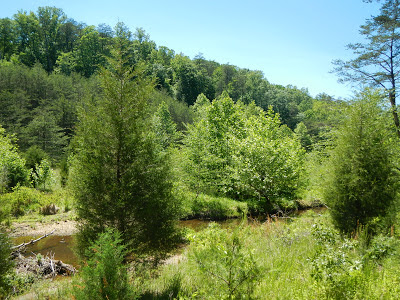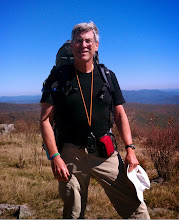In June of 1996, I accepted a job with a new company. Although the job was in Richmond, the company was headquartered in Alexandria, Virginia, which is near Washington, DC. They needed me to come up for the day before I started to fill out paperwork and get taken out to lunch, so I took a day off from my then current job to do so. It was a nice day, so I threw some hiking basics in the car, and on the way back, I stopped at Prince William Forest Park (near Quantico, Virginia) for a hike of a few miles.
The hike itself was very nice, but what struck me was the cicadas! As it turned out, the 17 year brood had morphed into adults and were everywhere! The sound was deafening. They were all over the trees, flying through the air, zipping past my head. It was fascinating but a little creepy too, to have these large insects buzzing past. But I made a decision that I would come back in 17 years once again. I quickly did the math in my head, and came up with 2013. Guess what? It is now 2013, so yesterday, on a simply gorgeous day, I went back.
There were lots and lots of cicadas. I could hear them everywhere as I hiked a 7.5 mile circuit, and I saw some. The holes where they emerged from the ground were all along the trail. But what I didn't see was them flying past, wings buzzing with tremendous sound. So that was a little disappointing. Maybe that would happen in June. Here is the map of my route, hiked clockwise as shown by the arrows, and the elevation profile. It is not a difficult hike, and is very pleasant. I hiked mainly on the Turkey Run Ridge Trail (west side of the map) and the North Valley Trail (east side), connecting on the Mary Bird Branch and Lake Quantico Cascades Trails.
The hike is through very pleasant forestland and much of it is along two streams. Other than cicadas and many butterflies, I didn't see much wildlife. I heard a pileated woodpecker hammering away, and I saw a young northern fence lizard - very difficult to spot these - and a yellow billed cockoo. I was thinking that the cockoo would make a great "what am I?" and I was maneuvering for a photo when a couple of hikers came by me and scared him away.
I am so glad that I lived these 17 years to come back here, surviving cancer along the way. Think of it - the animals I saw yesterday were new life in 1996! I saw their parents. For 17 years, they lived under the ground by the billions. Many of them died in that time. Human babies born the same year are now going to be seniors in high school! 16 springs and summers passed by, and they stayed under ground. And then somehow, on the 17th spring, it was time to mature, tunnel out of the earth, climb a tree, and shed their exoskeleton. They will live a few weeks as adults, feeding hungry creatures all over the forest. The luckiest will breed, lay their eggs, and then die. I know that a lot of people think they are disgusting, and even had a couple of folks tell me they wouldn't mind if they all just disappeared, but I see it as a simply amazing biological phenomina, one with few equals. My guess is that cicadas, and other insects, will still be on this earth when we humans have come to the end of our time.
I reflected yesterday that I have a decent shot, better than a coin flip, of seeing the children of these insects. But my chances of me seeing their grandchildren is pretty remote. I hope I can come back in 2030 and say to them, "Hey! I knew your mom and dad!" But life is uncertain, and I am just happy I got back their yesterday. Here are a few photos from my hike.
Green was the dominant color yesterday. It is my favorite color, so I was fine with that.
About as big around as a pencil eraser, these holes were everywhere I looked as I hiked along. They are where the 17 year old cicadas tunneled out of the ground.
I liked the blue in this butterfly.
A lot of the hike was along two pleasant streams, some with small cascades. The mountain laurel was in bloom during my hike.
There was lots of mature forest along the way.
This little northern fence lizard was just a couple of inches long, and difficult to spot.
Pyrite mining was once conducted here. This shows a reclaimed mine site.
The stars of the show, and the reason I came here yesterday! I saw these guys parents. If I am very lucky, I'll still be walking this earth to see their children in 17 years. And if I am fortunate beyond any reason, I will see their grandchildren!
Top 12 Moments in My Racing for a Cure Memories
10 years ago









































